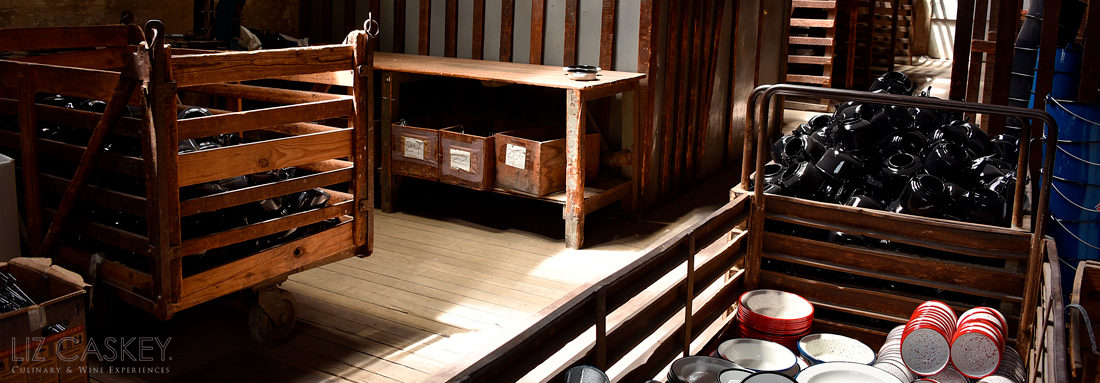I am back on the ground in Chile after a whirlwind “tour” promoting our culinary & wine tours business and Emiliana Orgánico wines with TV in Florida, cooking classes & wine pairings at Central Market in Texas, and wrapping up everything with the most fun tasting ever with clients in Shreveport, Louisiana. You know, I was born a northeaster (as “y’all” kept telling me to slow down when I speak) but I am absolutely smitten with the southern US. People are so friendly, the pace is slower, the weather is w-a-r-m. It’s a nice change from what was normal for me of the go-go-go mentality of New York.
While on tour, since it’s been a while since I have been in the US in November, I had forgotten how much emphasis gets placed on Thanksgiving. And yikes!, there seemed to be a lot of media focus on surefire ways to mitigate all the stress around entertaining for turkey day: travel, the best technique to cook your bird (deep-frying turkey? yep, in the South they are very into this), what are the best side dishes and then, hopefully not an afterthought, what wines should I be serving with this? This last question I have been constantly fielding so I thought I would share my personal suggestions on what I love to serve for Thanksgiving dinner at our house, which may give you some ideas for your own table this Thursday.
My approach is to pair wines with each course so you can sip, savor, and try more. It’s fun and gets people talking and your palate will thank you. To that effect, I am going to recommend some value-driven South American wines that will not only fit in your budget but also amaze your guests with the region’s diversity and show off your Chilean & Argentine wine saviness. Listos? Vamos ahi.
Appetizers
As a kid, in my house for T-giving, my grandpa would prepare a classic martini for himself, gin and tonic for my late grandmother, Dad nursed a Scottish single malt, and my Mom sipped (cringe!) white zinfandel. It wasn’t until I graduated from college and got into wine that I delved into the wine possibilities for this holiday. Given that Thanksgiving is a day of celebration, gratitude, and ultimately, sharing with friends and family, why are you saving that bubbly until New Year’s? Doesn’t this merit a toast?
Sparklers enchant. If I had to pick one type of wine for the rest of my life, this would probably be it. “Bubbly” can be perfect for all occasions and anything celebrated, not just holidays and special occasions. What all great bubblies have in common, that is champagne (which technically is only from the Champagne region in France) and other varieties like Prosecco, Cava and Sparkling wine, is vibrant acidity. I will repeat, vibrant acidity. What do this do with food? It pushes all the flavor buttons in what you’re eating and adds more oomph, verze, and sizzle to everything from goat cheese to tomatoes to roasted veggies, or even steak.
Luckily in Chile & Argentina, we have lots of options made in the traditional method from Champagne. In fact, in our house in Santiago, should you ever come visit, you’ll be given one of our favorite house sparklers upon entry. There are different styles out there, sweet or dry, but I always stick to the dry for the appetizer course. I love usually brut (no residual sugar whatsoever), blanc de blancs (made from all white grapes like Chardonnay, very elegant), or nature (also dry but with toasty notes). The commonality here is that they are crisp, refreshing, and your appetizers new best (food) friend.
Some of our favorites:
Cono Sur Brut NV, Chile (US$10): fleshy, hearty, intense with clean citrus notes. Love this with oysters, scallops, and roasted asparagus.
Viña Casablanca Blanc de Blancs, Chile (US$12): Fine bubbles and citrusy notes (think grapefruit) with aromas of wet stones and minerals and some toasty back notes. It goes down easy and never lasts.
Cruzat Nature, Argentina (US$20): Perhaps the “Krug” of South America, this delicious bubbly has fine bubbles is rich, toasty, clean, and the closest I have tried to traditional champagne in this part of the New World. Love it.
Cava Geisse Rosé, Brazil (US$20): Brazilian wine? Sim senhor(a). In the southernmost (read: cool) region, Rio Grande do Sul in the rolling, verdant hills, bubbly is king. Nobody knows their stuff like this house. Crunchy, earthy, and beautiful with pink hues, if you can find this it is worth opening your mind and palate to what’s next in South American wines: Brazil.
Dinner
Thanksgiving pays homage to the harvest so earthiness and deep, rich flavors blanket the spread on most tables. While this can range regionally from classic sweet potatoes to something more spicy in the Cajun bayou of Louisiana and Southeast Texas, generally speaking, turkey is going to work well with wines that pull up more of that earthy-sweetness inherent in the bird and accompanying dishes. Turkey is a delicate meat so a big red, like a Cabernet Sauvignon or Shiraz, will steal the show. Think of medium-body reds with silky tannins and loads of juicy fruit as your ideal partner.
Pinot Noir:
Pinot is b-o-o-m-i-n-g in Chile in the coastal regions of Casablanca and San Antonio. To be honest, if you blind tested, it would be a dead ringer for California’s Sonoma Coast, Carneros, or even some of the Williamette producers in Oregon. The key? They are keeping it in line with what the grape needs—cool temperatures and the right soils. Chilean Pinot has been a big of an “aha” for the international wine drinking community. The Pinots are elegant with subtle aromas of cherries, berries, sometimes ash or smoke, but subtlety is the word. In the mouth, they are concentrated and long leaving a pleasant after taste not unlike a bonbon. Pinot is almost always a safe bet with all drinkers since everybody adores its juicy flavor, medium body, and plush tannins.
Garcés Silva 2008 Pinot Noir, Chile (US$30): This is my favorite Pinot from Chile. It is seductive, sexy, and will captivate you from the first sip. Smooth, earthy, bringing up oodles of fresh berries, it seriously is pure love with anything earthy.
Matetic EQ 2008 Pinot Noir, Chile (US$35): Holy Cherries. This is a dark, sultry Pinot that becomes a real chameleon in the glass. I like that it eludes you a little at the beginning. Notes of smoke and velvety tannins rule. It really tangoes with turkey.
Kingston Family Vineyards Alazán Pinot Noir, Chile (US$25): Great price-quality ratio as you are easily buying a wine twice the quality of its retail price. Lots of cassis and black cherries are backed up by spicy notes, that “wet earth” aroma, and toasty aromas. Get it while it last, they don’t make very much of this and it only gets better as it aereates. Ahh.
Carmenere
Chile’s flagship varietal is actually a “lost” Bordeaux grape that had been brought over in the 19th century among Merlot cuttings. After phylloxera devastated the European vineyards, they thought it was wiped out—forever. Not the case, Chilean vintners had unknowingly planted this grape amid Merlot vines that were subsequently discovered in 1994. Carmenere is still not widely known but its time is coming—it is simply the most likeable wine out there. Versatility is the key word. Generally speaking, ripe Carmenere exudes an earthy nose that may hint of smoke, roasted peppers, spices like cumin and ground coriander seeds, fresh black plums and figs. Its mouth feel is seductive with soft tannins and a medium body that make it pair with a huge range of foods, especially turkey, sweet potatoes, heavenly stuffing or cornbread.
Haven’t tried it? Take the plunge.
Emiliana Orgánico Nature Carmenere, Chile (US$10): You cannot beat the bang for the buck with this all organic, fruity, straightforward Carmenere. I won’t lie, we poured this across Texas and it was a hit. Lots of red fruit and berries, lush in the mouth with a vibrant acidity, it goes with everything earthy and is sublime with hummus. If you’re entertaining a big crowd this Thanksgiving, this could be your winner.
Viu Manent Carmenere Reserva, Chile (US$15): Chocolate-laden like a wine bonbon, this dense, chewy Carmenere feels decadent in your mouth. Dark fruit and toasty notes with smooth tannins make this a major crowd pleaser. What are you waiting for?
Concha y Toro, Marqués de Concha Carmenere, Chile (US$18): Almost purple in color, think black plums, blackberries, and blueberries accented by tobacco, star anis, and a little oak. It is opulent, succulent, and rich in flavor. It’s not over the top though, balance rules with this baby.
Dessert? Nah, I have never been one for sweets (don’t lynch me!). But if you want to have your pumpkin pie, I guarantee whatever is leftover of the reds in your glass will be the perfect match with an earthy, spice-laden, soul warming dessert.
Happy Thanksgiving to you all! Let me know what you’re drinking this holiday!
Photo Credits: Thanks to Pretty Connected, Bernat Casero, and Daniel Greene for their festive pictures in this post.















